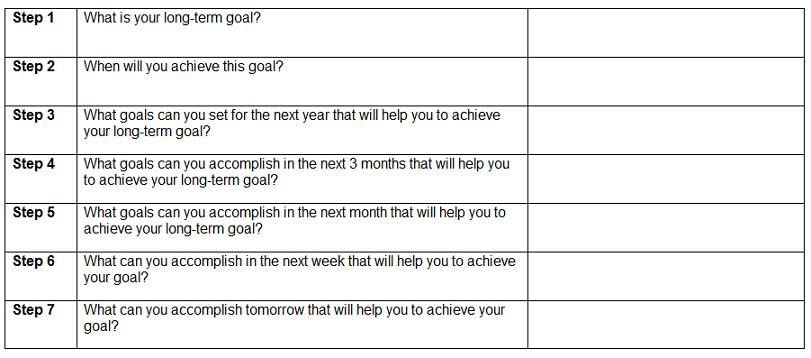



Copyright © 2004-2014 by GoalEnforcer, SVT Systems. All rights reserved.




Goal Setting and Achievement
Rules for Succesful Goal Setting
Realistic
–Winning a marathon after two weeks of training is an unrealistic goal. Use what you’ve accomplished in the past to set a reasonable goal for the future.
Self-chosen
–You are much more likely to achieve a goal that you set for yourself than one that has been set for you.
Moderately difficult
–A goal that is too hard or too easy will decrease your motivation and won’t show you what you’re really capable of accomplishing. Use what you’ve accomplished in the past as a guide
Specific
–Getting an “A” in Math and a “B” in Geography is much more specific than just saying that you would like to get good grades this semester
Measurable
–You’re more likely to keep up if you can see progress toward your goal. For example, getting an “A” on your midterm is measurable progress toward getting an “A” in the class.
Positive
–Say what you do want to accomplish instead of what you don’t want to do. “I will attend all classes,” is much better than “I won’t skip any classes.”
Flexible
–If it looks like you can’t reach your original goal, be flexible and redraw your plan
Associated with a deadline
–When do you plan on accomplishing this goal, in a month, day, or year?
Written down
–It will serve as a better reminder to keep you motivated
–Winning a marathon after two weeks of training is an unrealistic goal. Use what you’ve accomplished in the past to set a reasonable goal for the future.
Self-chosen
–You are much more likely to achieve a goal that you set for yourself than one that has been set for you.
Moderately difficult
–A goal that is too hard or too easy will decrease your motivation and won’t show you what you’re really capable of accomplishing. Use what you’ve accomplished in the past as a guide
Specific
–Getting an “A” in Math and a “B” in Geography is much more specific than just saying that you would like to get good grades this semester
Measurable
–You’re more likely to keep up if you can see progress toward your goal. For example, getting an “A” on your midterm is measurable progress toward getting an “A” in the class.
Positive
–Say what you do want to accomplish instead of what you don’t want to do. “I will attend all classes,” is much better than “I won’t skip any classes.”
Flexible
–If it looks like you can’t reach your original goal, be flexible and redraw your plan
Associated with a deadline
–When do you plan on accomplishing this goal, in a month, day, or year?
Written down
–It will serve as a better reminder to keep you motivated
Goals must be:
Where goal setting can go wrong
When goal setting is disorganized
–For example, keep personal and academic goals separate
When goals are unrealistic
–For example, becoming a company CEO immediately after graduation is an unrealistic goal
Goals that are ‘beyond’ your control
–For example, winning the lottery is definitely beyond your control
When goals are vague
–For example, “becoming successful” or “becoming a better student” are not clear goals to work toward.
When you set too many goals
–At any one time you should focus on achieving only three or four goals
–For example, keep personal and academic goals separate
When goals are unrealistic
–For example, becoming a company CEO immediately after graduation is an unrealistic goal
Goals that are ‘beyond’ your control
–For example, winning the lottery is definitely beyond your control
When goals are vague
–For example, “becoming successful” or “becoming a better student” are not clear goals to work toward.
When you set too many goals
–At any one time you should focus on achieving only three or four goals
How to break down and achieve goals
Step 1
What is your long-term goal?
Earn College degree
Step 2
When will you achieve this goal?
3 years- Fall 2002
Step 3
What goals can you set for the next year that will help you to achieve your long-term goal?
(1) Maintain cumulative GPA of 3.5 in classes ,(2) schedule 3 classes Fall and Spring semesters
Step 4
What goals can you accomplish in the next 3 months that will help you to achieve your long-term goal?
(1) ‘B’ in history, (2)’ A’ in Math, (3) ‘A’ in English, (4) attend all classes, (5) spend at least 10 hours/wk studying
Step 5
What goals can you accomplish in the next month that will help you to achieve your long-term goal?
(1) ‘A’ on history project (2) ‘B’ on Math test (3) ‘A’ on English term paper
Step 6
What can you accomplish in the next week that will help you to achieve your goal?
(1) Develop study plan for next math exam, (2) Make outline for history project, (3) Hand in rough draft
Step 7
What can you accomplish tomorrow that will help you to achieve your goal?
(1) Attend classes, (2) Complete math problem set, (3) Read chapters 8-10 for English
What resources are available to you to help you achieve your goal?
· Advisor
· Instructors
· Tutoring
· Study Groups
· Computer Labs
· Other students
What is your long-term goal?
Earn College degree
Step 2
When will you achieve this goal?
3 years- Fall 2002
Step 3
What goals can you set for the next year that will help you to achieve your long-term goal?
(1) Maintain cumulative GPA of 3.5 in classes ,(2) schedule 3 classes Fall and Spring semesters
Step 4
What goals can you accomplish in the next 3 months that will help you to achieve your long-term goal?
(1) ‘B’ in history, (2)’ A’ in Math, (3) ‘A’ in English, (4) attend all classes, (5) spend at least 10 hours/wk studying
Step 5
What goals can you accomplish in the next month that will help you to achieve your long-term goal?
(1) ‘A’ on history project (2) ‘B’ on Math test (3) ‘A’ on English term paper
Step 6
What can you accomplish in the next week that will help you to achieve your goal?
(1) Develop study plan for next math exam, (2) Make outline for history project, (3) Hand in rough draft
Step 7
What can you accomplish tomorrow that will help you to achieve your goal?
(1) Attend classes, (2) Complete math problem set, (3) Read chapters 8-10 for English
What resources are available to you to help you achieve your goal?
· Advisor
· Instructors
· Tutoring
· Study Groups
· Computer Labs
· Other students
- Goals with certain characteristics will enable you to be more successful in goal setting and achievement.
- Breaking down large goals into parts will help you to see what steps you will need to complete on the way to accomplishing your goal
- Breaking down large goals into parts will help you to see what steps you will need to complete on the way to accomplishing your goal
Start Setting Your Goals Today
- Set an academic or personal goal.
- Select one personal or academic long-term goal and break it down to the steps you will need to achieve in the next year, next 6 months, next month, next week, and tomorrow.
- Select one personal or academic long-term goal and break it down to the steps you will need to achieve in the next year, next 6 months, next month, next week, and tomorrow.



Academic Goal Example:
Remember:


